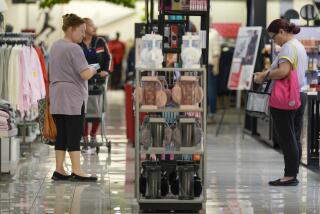Firms Flush With Cash Still Wary of Spending
- Share via
NEW YORK — They’ve got the money. Now, will they really spend it?
After years of the consumer being the key driver of U.S. economic growth, “the baton has been passed” to business, said Wells Fargo & Co. economist Sung Won Sohn. And bolstered by tremendous profit growth, companies are showing a willingness to step up: Although the pace of consumer spending slowed sharply in the second quarter, corporate capital spending rose at an 8.9% annualized rate from 4.2% in the previous quarter, the Commerce Department said Friday in its initial estimate of spring gross domestic product growth.
Business outlays for capital equipment, as opposed to new plant construction, have been particularly strong. Spending on equipment and software rose at a 10% rate in the second quarter, up from 8% in the first quarter, the government said.
But for all that, there remain signs of doubt and parsimony in executive suites.
Cash is rolling into corporate coffers by the truckload, but spending, relatively speaking, is being doled out by the capful.
According to John Lonski, senior economist for Moody’s Investors Service, corporate cash flow relative to capital outlays has reached the highest level since 1959 for non-financial companies. And if being flush with cash weren’t enough, corporate credit rating upgrades are outpacing downgrades, meaning that companies’ balance sheets are getting cleaner and borrowing capacity is rising.
All told, not since the Eisenhower administration have business wallets been so fat -- and many business leaders so determined to sit on them.
Some of the reasons for the caution are both obvious and understandable, analysts say.
The threat of repeat terror attacks, in the wake of Sept. 11, 2001, is a shadow that did not darken previous economic recoveries. The government warnings issued Sunday may only deepen those concerns.
Second, the bursting of the technology-sector bubble in 2000 is a still-fresh reminder to those who control the corporate purse strings that the hangover from an ill-considered capital investment binge can last for years.
Third, gasoline prices are at record highs, which is depressing consumer spending. Also, interest rates are rising from historically low levels. Bigger loan payments could further pinch consumers’ finances.
Companies worry that they might finally decide to ramp up production of goods or services just as buyers head to the sidelines. Concern about the economic outlook has shown up in forecasts some companies have made for their sales and earnings in the second half.
Second-quarter profit reports have been robust overall: Of the 406 companies in the blue-chip Standard & Poor’s 500 index that have reported results so far, 69% have exceeded analysts’ estimates, and total operating profit is up 27.9% from a year earlier, according to data firm Thomson First Call in Boston. The quarter is on track to be the fourth straight of 20%-plus earnings growth, Thomson said.
But 64 companies in the S&P; 500 already have warned that results in the current quarter would fall short of expectations. By contrast, at this point in the second quarter just 39 firms in the S&P; 500 had issued warnings about that period’s results.
EBay Inc., for example, reported a doubling of year-over-year profit in the second quarter, beating Wall Street’s consensus estimate. But the online auctioneer’s stock sank after the firm gave earnings projections for the current quarter and the rest of the year that fell just short of analysts’ lofty expectations.
General Motors Corp. reported quarterly profit that beat analysts’ expectations by 12 cents a share, but the automaker spooked some investors because it declined to raise its earnings estimates for the rest of the year.
Similarly, the market ignored a 25% quarterly profit increase at 3M Co., focusing instead on the firm’s comment that “geopolitical uncertainty” was tempering its second-half outlook.
Such yellow flags have curbed investor enthusiasm, causing a broad-based stock market slide that lasted most of July.
The S&P; 500 index and the technology-dominated Nasdaq composite index both hit lows for the year last Monday. Stocks staged a mild recovery later last week, but it remains to be seen whether it can be sustained.
The market’s next move may help determine whether corporate spending continues to surge.
Companies react to the stock market in much the same way that consumers do, said Liz Ann Sonders, chief investment strategist for Charles Schwab & Co.: When share prices are rising, the effect is to boost confidence among executives, which can spur business spending.
Still, Sonders said, the fundamentals matter more, and they point to robust business investment ahead.
To be sure, terrorism fears, the situation in Iraq and other geopolitical tensions are negatives for business spending, but in Sonders’ view, they are outweighed by such positives as pent-up demand for new equipment, companies’ “incredibly strong cash position” and a federal tax incentive for capital expenditures that is scheduled to expire at year-end.
Bill Zadrozny, chief executive of New York-based Siemens Financial Services, the financing arm of giant German manufacturer Siemens, said companies have been “squeezing more out of existing facilities,” while waiting to see whether the economic expansion was sustainable.
He believes that many business managers are “feeling good and starting to get comfortable” with the idea of boosting capital expenditures. Zadrozny, like Sonders, thinks corporate spending will continue to rise, with the big money starting to flow in the second and third quarters of next year.
By that point, he said, the pickup in equipment spending may give way to plant expansion and new construction, which should lead to increased hiring.
If that happens, a recovery that has been stingy in terms of job creation may start displaying more traditional employment growth, analysts say.
More to Read
Inside the business of entertainment
The Wide Shot brings you news, analysis and insights on everything from streaming wars to production — and what it all means for the future.
You may occasionally receive promotional content from the Los Angeles Times.










